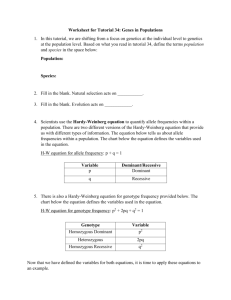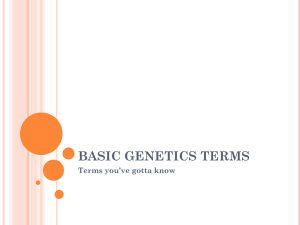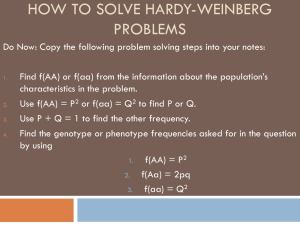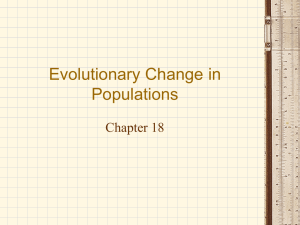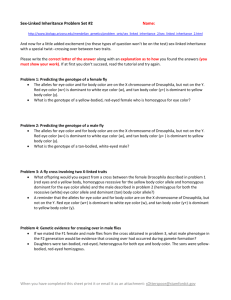docx - Bean Beetles
advertisement
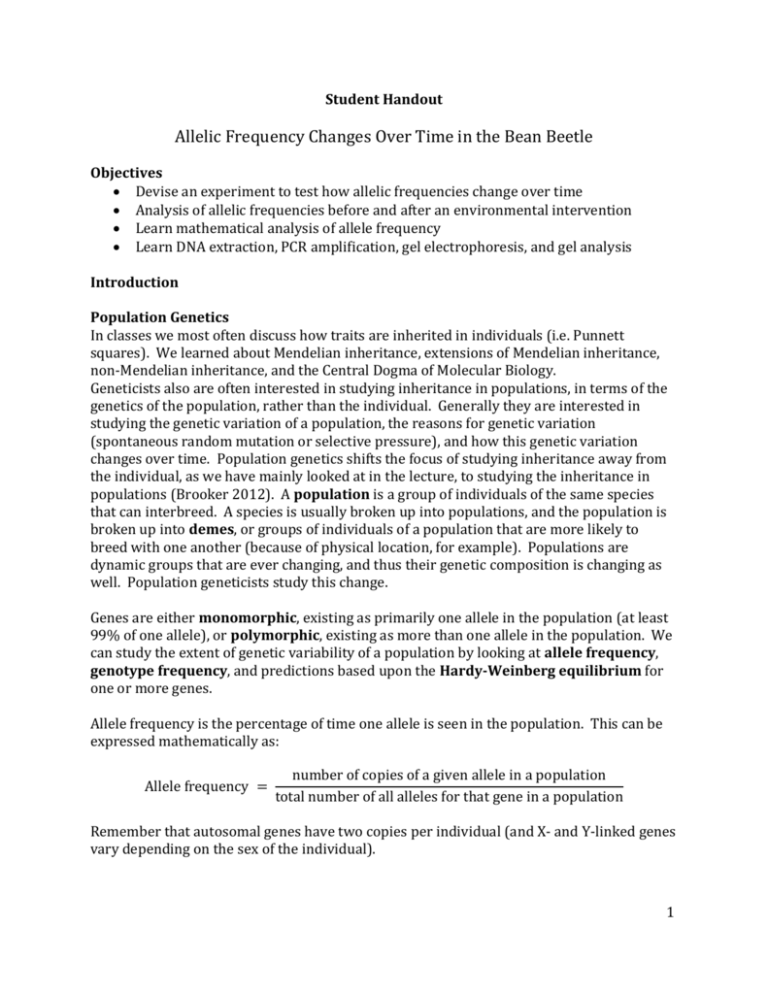
Student Handout Allelic Frequency Changes Over Time in the Bean Beetle Objectives Devise an experiment to test how allelic frequencies change over time Analysis of allelic frequencies before and after an environmental intervention Learn mathematical analysis of allele frequency Learn DNA extraction, PCR amplification, gel electrophoresis, and gel analysis Introduction Population Genetics In classes we most often discuss how traits are inherited in individuals (i.e. Punnett squares). We learned about Mendelian inheritance, extensions of Mendelian inheritance, non-Mendelian inheritance, and the Central Dogma of Molecular Biology. Geneticists also are often interested in studying inheritance in populations, in terms of the genetics of the population, rather than the individual. Generally they are interested in studying the genetic variation of a population, the reasons for genetic variation (spontaneous random mutation or selective pressure), and how this genetic variation changes over time. Population genetics shifts the focus of studying inheritance away from the individual, as we have mainly looked at in the lecture, to studying the inheritance in populations (Brooker 2012). A population is a group of individuals of the same species that can interbreed. A species is usually broken up into populations, and the population is broken up into demes, or groups of individuals of a population that are more likely to breed with one another (because of physical location, for example). Populations are dynamic groups that are ever changing, and thus their genetic composition is changing as well. Population geneticists study this change. Genes are either monomorphic, existing as primarily one allele in the population (at least 99% of one allele), or polymorphic, existing as more than one allele in the population. We can study the extent of genetic variability of a population by looking at allele frequency, genotype frequency, and predictions based upon the Hardy-Weinberg equilibrium for one or more genes. Allele frequency is the percentage of time one allele is seen in the population. This can be expressed mathematically as: Allele frequency = number of copies of a given allele in a population total number of all alleles for that gene in a population Remember that autosomal genes have two copies per individual (and X- and Y-linked genes vary depending on the sex of the individual). 1 Genotype frequency is the percentage of individuals that has a given genotype. This can be expressed mathematically as: Genotype frequency = number of individuals with a particular genotype in a population total number of all individuals in a population So for a biallelic gene (one with two alleles in a population), there are two allele frequencies to calculate (dominant and recessive) and three genotype frequencies (homozygous dominant, heterozygous, and homozygous recessive). One can predict the stability of genetic frequencies in populations from one generation to the next. This is the Hardy-Weinberg equilibrium, and it can be used to calculate allele frequencies from genotype frequencies and vice-versa. This is a quadratic equation with two parts. For a biallelic loci: p+q=1 p is the allele frequency of the dominant allele and q is the allele frequency of the recessive allele and: p2 + 2pq + q2 = 1 2 p is the genotype frequency of the homozygous dominant, 2pq is the genotype frequency of the heterozygote, and q2 is the genotype frequency of the homozygous recessive. This is an equilibrium equation, predicting stability in allele and genotype frequencies from one generation to the next. In order for the Hardy-Weinberg equilibrium to hold true, several conditions must be met: 1. the population is so large that allele frequencies do not change due to random effects 2. the members of the population show no preference in mate choice 3. there is no migration between populations 4. there is no survival or reproductive advantage of any of the alleles 5. no new mutations occur in the gene of interest Example of H-W equation use In humans, the ability to roll one’s tongue is inherited as a recessive trait. Approximately 40% of people are able to roll their tongue. So, what is 40%? This is the frequency of the recessive trait, which is seen only in homozygous recessive individuals, so this is q2. So, q2 = 0.4. From this number we can get everything else! q = 0.63 and p + q = 1, so p = 0.37 but what are p and q? p is the allele frequency of the dominant allele and q is the allele frequency of the recessive allele. So how many heterozygote carriers are there? We’d figure this out by solving for 2pq = 0.47, or about half the population is a heterozygous carrier! This estimate assumes that the population in question is in Hardy-Weinberg equilibrium. 2 Another example You perform allozyme analysis on a wild Pam pamulus population and determine that for the phosphoglucomutase enzyme (which is autosomal), there are 25 homozygous dominant, 32 heterozygous, and 21 homozygous recessive critters. You can solve for allele frequency for this allozyme: Allele frequency = number of copies of a given allele in a population total number of all alleles for that gene in a population Dominant allele = [25(2)] + 32 = 0.53 78(2) Hey, wait a minute. Why did I multiply 25 by two? Because the homozygous dominant has two dominant alleles! And why did I multiply 78 by two? Each individual has two alleles so the total alleles in the population is the total number of individuals multiplied by two! And so p = 0.53 q = 0.47, you can get this number one of two ways, solving for q in p + q = 1 or figuring out the allele frequency using Recessive allele = number of copies of a given allele in a population [21(2)] + 32 = total number of all alleles for that gene in a population 78(2) Once you have p and q, you can conquer the world! Ok, not literally. Let’s also solve for genotype frequency, just for fun. Genotype frequency = number of individuals with a particular genotype in a population total number of all individuals in a population genotype frequency of the homozygous dominant 25/78 = 0.32 genotype frequency of the heterozygous 32/78 = 0.41 genotype frequency of the homozygous recessive 21/78 = 0.27 or we can use the HARDY-WEINBERG equilibrium, p2 = (0.53)2 = 0.28 (genotype frequency of the homozygous dominant) 2pq= 0.50 (genotype frequency of heterozygote) q2 = 0.22 (genotype frequency of the homozygous recessive) Wait, wait, wait a minute. These numbers are different than our observed results!!!!!!!! Oh, no. What do I do? Observed results, expected results (from the HARDY-WEINBERG equilibrium expectations), well… of course, your instructor is going to make you perform a Chi-square analysis! Oh, joy. 3 Σ (observed – expected)2 𝜒 = expected 2 observed: homozygous dominant heterozygous homozygous recessive 25 32 21 expected: homozygous dominant heterozygous homozygous recessive 78(0.28) = 22 78(0.50) = 39 78(0.22) = 17 remember for Chi-square analysis, we use the number of individuals, not a frequency, so that’s why we had to multiply to get the expected. Σ (observed – expected)2 (25 − 22)2 (32 − 39)2 (21 − 17)2 2 𝜒 = = + + = 2.61 expected 22 39 17 with one degree of freedom, we accept that the population is in Hardy-Weinberg equilibrium. For a polyallelic situation, this can be more complicated, but the same equations hold true. For a population of cows in which there are three alleles, X, Y, and Z, we can determine the allele frequency as follows: There are: 52 cows that are XX 27 cows that are XY 7 cows that are XZ 15 cows that are YY 22 cows that are YZ 4 cows that are ZZ total cows are 127 allele frequency of X = [52(2) + 27 + 7]/127(2)=54% allele frequency of Y = [27 + 2(15) + 22]/127(2)=31% allele frequency of Z = [7 + 22 + 4(2)]/127(2)=15% genotype frequency of XX = 52/127=41% genotype frequency of XY = 27/127=21% 4 genotype frequency of XZ = 7/127=6% genotype frequency of YY = 15/127=12% genotype frequency of YZ = 22/127=17% genotype frequency of ZZ = 4/127=3% Hardy-Weinberg for this case becomes p2 + 2pq + q2 + 2pr + 2qr + r2 = 1.0 and then p + q + r = 1.0 This population of cows is not in H-W equilibrium. How do I know? Populations are often out of Hardy-Weinberg equilibrium, for whatever reason. It can be because of a small sample size, a population bottleneck, selective pressure, environmental changes, or other reasons. In this study, YOU will design an experiment to test a hypothesis you will create. Your hypothesis should cover a question of allelic frequency, utilizing the bean beetle, Callosobruchus maculatus. This beetle has a rapid generation time and is easily handled, making it an ideal experimental organism for many questions. There are also several bi- and polyallelic loci (Berg and Mitchell 1993, Fleurat-Lessard and Pronier 2006, Gill et al 2006, Raja, William and Hussain 2009). For example, you may decide to perform a treatment on bean beetles that you hypothesize would skew allelic frequency. You will need to test the allelic frequency before and after the treatment, devise the treatment, and carry it out. Materials Your instructor will supply you with bean beetle, Callosobruchus maculatus, cultures to use in your experiment. Supplies for extracting and purifying genomic DNA from the beetles will be available. One means of evaluating allele frequencies is to use a PCR primer for a region of the genome that is known to be polymorphic. Previous investigators have determined that the PCR primer P7 amplifies a polymorphic region of the bean beetle genome (Smith and Hicks 2012). This primer also will be available with the equipment and supplies for conducting PCR. The p7 primer pair is 5’AGGTTGCAGAAGGAGGCTCT3’ forward and 5’CCGTCCTGGAGCCATATCT3’ reverse. This primer pair amplifies a short tandem repeat (STR) that was identified by Smith and Hicks (2012) in their search for polymorphic loci in bean beetles. 5 Experimental Design 1. Assess the baseline pre-treatment allelic frequency of your bean beetle population. You will need to analyze individual beetles by PCR to do this. A. Isolate bean beetle DNA utilizing the Qiagen DNeasy Blood and Tissue Kit. Take one beetle, either fresh or previously frozen at -20C, and macerate it in a microfuge tube using a minipestle and 180 l of PBS. Then follow the directions in the kit to isolate the DNA. The detailed instructions are: EXTRACTION Place 1 beetle into a 1.5ml micro-centrifuge tube. Add 180µl of PBS Crush beetle with sterilized pestle until a mostly homogenous mix is obtained. Some bits of shell and wing will remain fully intact, this is alright. Add 20µl of Proteinase K with pipette. Add 200µl of Buffer AL with pipette. Vortex solution vigorously for 5 seconds. Place solution in hot water bath at 56°C for 10 minutes. Add 200µl ethanol with pipette. Vortex solution vigorously for 5 seconds. Transfer solution to DNEasy spin column. Centrifuge solution at 8,000rpm for 1 minute. Discard flow-through. Add 500µl of AW1 buffer to column with pipette. Centrifuge solution at 8,000rpm for 1 minute. Discard flow-through. Add 500µl of AW2 buffer to column with pipette. Centrifuge solution at 8,000rpm for 1 minute. Discard flow-through. Transfer column to a clean micro-centrifuge tube. Add 200µl of AE buffer to column with pipette. Let column stand for 1 minute at room temp. Centrifuge solution at 8,000rpm for 1 minute. Flow-through contains your extracted DNA. Store it on ice while you prepare for PCR. B. Take 3 l of your final DNA extract, mix with 45 l of Invitrogen Platinum PCR Supermix, and 1 l each of primers P7 forward and reverse in a thin walled PCR tube. Vortex then spin gently. 6 C. Run a PCR reaction consisting of the following sequence: 94°C X 5 minutes Then cycle: 94°C X 1 minute 50°C X 1 minute 72°C X 1 minute REPEAT for 40 cycles Finish with 72°C for 7 minutes, then hold at 4°C D. Run a 1.9% gel analyzing the PCR products. P7 is triallelic with DNA amplified at ~200kb, ~150kb, ~100kb. E. Using the equations above, determine observed allelic frequency of the starting population. 2. Design alternative hypotheses about the effect of an environmental treatment on allelic frequencies. For example, your hypothesis may be similar to, “if I treat the bean beetles with XX treatment, then the allelic frequency will change in YY way.” Be creative. 3. Devise your experiment and begin the treatment. The longer the treatment can continue, the better the analysis. a. After 2 weeks, remove the adults to allow the F1 population to emerge without allowing them to mate with the original population. b. After 2 more weeks, remove the F1s, to allow the F2s to emerge, and so forth, to try to get generations that are not mating with their parents. 4. At the end of the treatment, repeat steps 1 and 2 above to determine the post-treatment allelic frequencies. Questions to Answer 1. 2. 3. 4. 5. 6. What was your starting allelic frequency? What were your hypotheses? What was your experiment? How did you treat the beetles? Why did you think the allelic frequency would change with that treatment? How did you ensure that offspring did not mate with parents? 7 7. How many generations did you have? 8. What was your ending allelic frequency? 9. Was either population in Hardy-Weinberg equilibrium? 10. Design an additional experiment extending your work. What would you do next? Literature Cited Berg, D.J. and Mitchell, R. 1993. Associations of allozyme variation and behavior in the cowpea weevil (Callosobruchus maculatus). Entomologia Experimentalis et Applicata 69(3):215-220. Brooker, R.J. 2012. Genetics: Analysis and Principles 4th ed. McGraw Hill: New York, NY. Fleurat-Lessard, F. and Pronier, V. 2006. Genetic differentiation at the inter- and intraspecific level of stored grain insects using a simple molecular approach (RAPD). Proceedings of the 9th International Working Conference on Stored-Product Protection PS5-9 – 6305:446-455. Gill, T.k., Kumri, S., Sharma, V.L., Badran, A.A., Kumari, M. and Sobit, R.C. 2006. Genetic variation in polymorphic males of Callosobruchus maculatus (Coleoptera: Bruchidae) by RAPD-PCR. Cytologia 71(1):57-62. Raja, M., William, S.J., and Hussain, K.J. 2009. Genetic diversity of Callosbruchus maculatus (Fab.) (Coleoptera: Bruchidae) populations. International Journal of Integrative Biology 8(1):15-18. Smith, J. and K. Hicks. 2012. Detecting genetic polymorphisms in different bean beetles populations. www.beanbeetles.org/protocols Acknowledgments This experiment was developed with the assistance of Bentley J. Hanish, Matthew Lam, Keeley Lee, Braelen D. Svoboda, students at Arizona State University at the West Campus. This experiment was written by Pamela A. Marshall and Lara Ferry (Beanbeetles.org). 8

